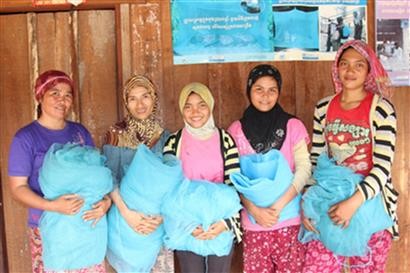
In rural Cambodia, Si Dara’s employee health coverage starts with nets covering beds. Each seasonal worker on Dara’s farm gets an insecticide-treated net—an effective way to keep biting mosquitoes from spreading malaria among her workers. It also saves time and energy caring for sick migrant workers.
“In late 2011 until early 2012, on average, 10 of my workers got malaria each month,” she said. “I spent so much money to get them treated by private health-care providers. I knew that they had malaria, but I didn’t know how malaria occurred. I thought maybe those workers did not have good hygiene.”
USAID, which has supported malaria control in Cambodia’s western Battambang province since 2012, launched a bednet-lending program that year for seasonal farmers working on agricultural plantations that continues today. Farm owners loan bednets to the workers and collect them when the workers leave. Because worker turnover is high, this arrangement reduces the number of bednets needed at the farms. Staff members under the program, which is supported by the U.S. President’s Malaria Initiative, also teach farmers about malaria prevention and treatment, drug compliance and counterfeit or sub-standard drugs.
The results have very positive. Dara noticed that, in the second half of 2012, the number of malaria cases on her farm each month dropped from 10 to one. And no one has been sick with malaria at all in 2013 as of mid-December.
Drug-resistant malaria has been a continuing problem in the fertile area of western Cambodia since its emergence in the 1960s. Much of the forested areas—and malaria breeding grounds—which disappeared to deforestation in the 1970s and 1980s have since been replaced by rubber plantations, which are equally attractive to malaria-carrying mosquitoes.
Cambodia has bolstered its efforts to combat malaria, but authorities have mostly distributed insecticide-treated bednets among locally registered residents, not the many short-term seasonal workers who travel in and out of malaria endemic areas. Workers coming from provinces where malaria is not as common were not fully aware of the risk. Many did not bring mosquito nets with them and many fell sick.
As part of a regional program, USAID also carries out malaria prevention and case management in 10 operational health districts in seven provinces bordering Thailand and Vietnam where there is evidence or threat of artemisinin drug resistance. In 2012 and 2013, USAID worked closely with the Cambodian National Malaria Control Program and distributed over 1 million bednets with funding from the Global Fund to Fight AIDS, Tuberculosis and Malaria. In addition, those traveling to work in endemic areas receive malaria information in buses and taxis through short video clips and discussions with drivers who have received malaria training. The program will continue until September 2016.
The increased field efforts are having the desired effect. In 2012, the Cambodian National Malaria Control Program reported over 74,000 cases of malaria diagnosed in public health facilities and by village malaria workers. This was a 32 percent reduction from the nearly 110,000 cases diagnosed in 2011. In 2013, 125 health facilities and 583 village-based malaria workers tested nearly 63,000 people and treated just under 12,500 patients who tested positive for malaria.







Comment
Make a general inquiry or suggest an improvement.